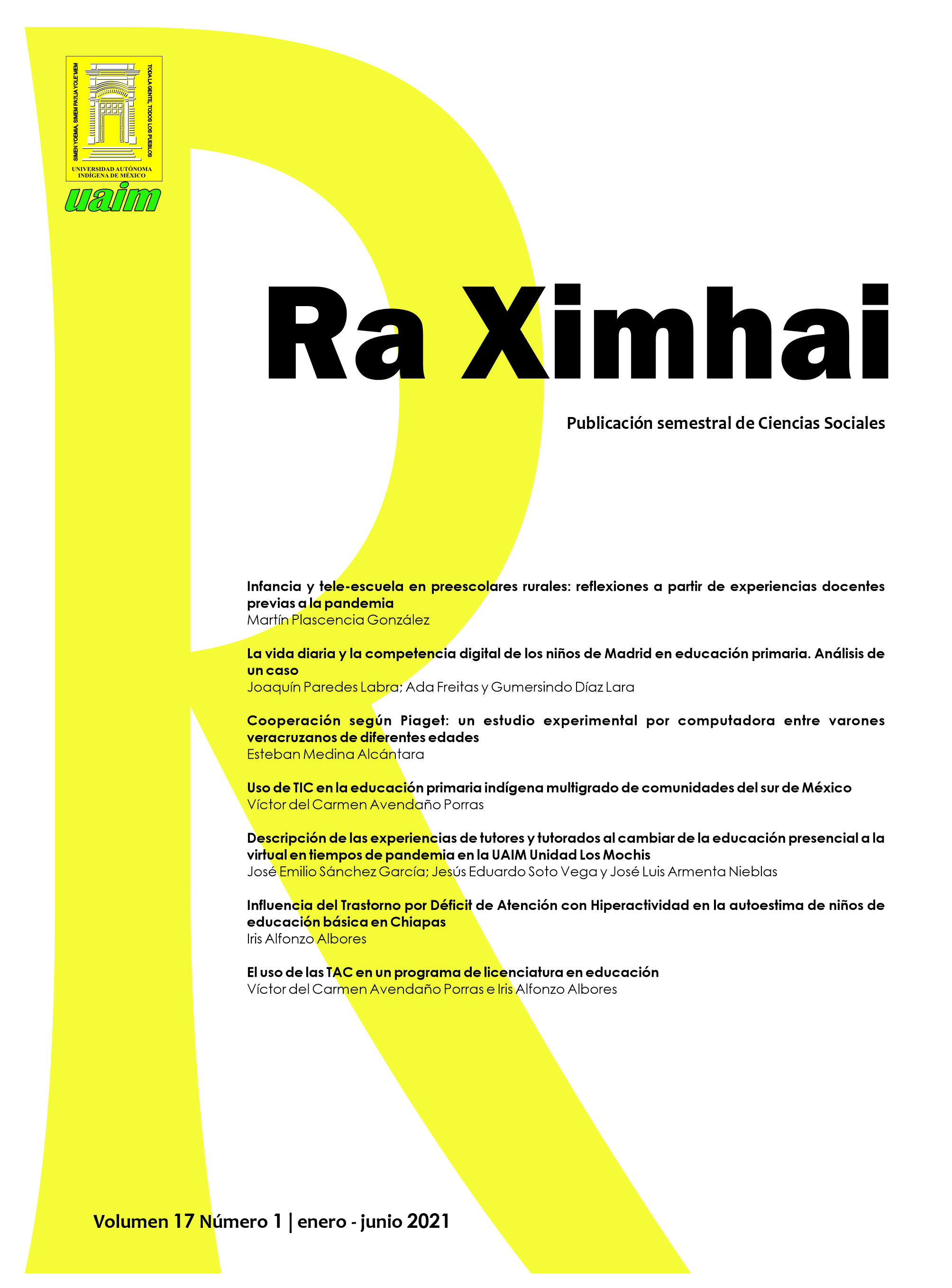A description of the experiences of tutors and tutored when changing from presential to virtual education in times of pandemics at Uaim Los Mochis Unit
DOI:
https://doi.org/10.35197/rx.17.01.2021.05.jsKeywords:
Pandemic, COVID-19, virtual learning, distance education, tutors, mentoringAbstract
The unexpected change that has occurred at the Autonomous Indigenous University of Mexico, Los Mochis Unit, to provide virtual education as a result of the pandemic, has caused different situations in the events of the educational institution and has made visible that there is a lack of computer equipment and digital skills of teachers who also have the function of tutors, likewise, problems have arisen in students who are tutored and who also lack equipment and internet connection, to address these problems and understand them, the qualitative paradigm has been used with the hermeneutic method, as a technique, the online interview has been used through the ZOOM platform to tutors and tutees, precisely because of the health emergency situation and the Atlas.ti tool has been used for data analysis, as a result it was obtained that from the perspective of the tutors three categories emerged: 1) personalized attention to the tutees is necessary, 2) that the tutors still are in a process of adaptation to the change from face-to-face to virtual education and 3) that there is a lack of computer equipment to attend to their virtual education activities, now from the perspective of the tutees three emerging categories were generated: 1) teachers do not give sessions by videoconference, 2) desertion is something that is already in the minds of some tutees and 3) that there is a lack of academic attention to students, it has been concluded with the evidence obtained that it is the lack of computer equipment of the teachers in this case of the tutors which affects the problems of the tutees, the Internet is also a factor but of lesser frequency and rooting.
Downloads
References
Alcántara, S. A. (2020). Educación superior y COVID-19: una perspectiva comparada. Uni- versidad Nacional Autónoma de México, Instituto de Investigaciones sobre la Universi- dad y la Educación., 75-82.
De Brouwer, E., Raimondi, D., y Moreau, Y. (2020). Modeling the COVID-19 outbreaks and the effectiveness of the containment measures adopted across countries. medRxiv, 1–8. 10.1101/2020.04.02.20046375do.
Diario Oficial de la Federación. (16 de Marzo de 2020). Recuperado de https://www.gob.mx/ cms/uploads/attachment/file/543994/Acuerdos_Covid_19_DOF_27_03_20.pdf.pdf. pdf.pdf
González, V. L. (2020). Estrés Académico en Estudiantes Universitarios Asociado a la Pande- mia por COVID-19. Espacio I+D. Innovación Más Desarrollo, 158-179.
Instituto Nacional de Estadística y Geografía (INEGI) (2020). Tecnologías de la información y comunicaciones TIC’s en hogares. México: INEGI. Recuperado de https://www.inegi. org.mx/temas/ticshogares/
Khachfe, H. H., Chahrour, M., Sammouri, J., Salhab, H., Makki, B. E., & Fares, M. (2020). An Epidemiological Study on COVID-19: A Rapidly Spreading Disease. Cureus, 12 (3) doi: E7313. 10.7759/cureus.7313.
Lederman, D. (2020). Will shift to remote teaching be boon or bane for online learning? Inside Higher Ed. Recuperado el 18 de septiembre de 2020 de https://www.insidehighe- red.com/digital-learning/article/2020/03/18/most-teaching-going-remote-will-help-or- hurt-online-learning
Lugo, M. D., Zamarripa, M. de J., Anzures, S. (2020). La reconversión educativa. Voces y experiencias de educadores en México. Revista Latinoamericana de Estudios Educativos (México),255-262.
Martinez, J. (2020). Take this pandemic moment to improve education. EduSource . Recu- perado de https://edsource.org/2020/take-this-pandemic-moment-to-improve- educa- tion/633500.
Mendoza, L. (2020). Lo que la pandemia nos enseñó sobre la educación a distancia. Revista Latinoamericana de Estudios Educativos (México), 343-352.
OIT (2020). OIT: La pérdida de empleo se dispara, y casi la mitad de la población activa mundial podría llegar a perder los medios de vida. Organización Internacional del Trabajo. Recupe- rado el 8 de noviembre de 2020 de https://www.ilo.org/global/about-the-ilo/newsroom/ news/WCMS_743056/lang--es/index.htm
ONU (2020). La ONU estima que 850 millones de niños y jóvenes están sin clase por el corona- virus. Leonoticias. Recuperado el 20 de noviembre de 2020 de https://www.leonoticias. com/sociedad/educacion/onu-alumnos-sin-clase-20200318165312-ntrc.html?ref=ht- tps%3A%2F%2Fwww.google.com%2F
Remuzzi, A. y Remuzzi, G. (2020). COVID-19 and Italy: What next? Lancet, 395, 1225– 1228. 10.1016/S0140-6736(20)30627-9.
Schmelkes, S. (2020). La educación superior ante la pandemia de la Covid-19: el caso de Mé- xico. Universidades, 73-87.
Schulten, K. (2020). Coronavirus resources: Teaching, learning and thinking critically. The New York Times. Recuperado el 8 de noviembre de 2020 de https://www.nytimes. com/2020/03/11/learning/coronavirus-resources-teaching-learning-and-thinking-criti- cally.html
UAIM. (2020). UAIM acata disposiciones de la SEP y del Sector Salud. UAIM. Recuperado 26 de diciembre de 2020 de http://uais.edu.mx/portal/index.php/noticias/643-uaim-acata- disposiciones-de-la-sep-y-del-sector-salud
UAIM. (2020). “Nuestra prioridad es la educación:” Ibarra Ceceña. UAIM. Recuperado el 27 de noviembre de 2020 de http://uais.edu.mx/portal/index.php/noticias/652-nuestra-prio- ridad-es-la-educacion-ibarra-cecena
UNESCO/IESALC. (2020). ¿Cómo prepararse para la reapertura? Estas son las recomendaciones del IESALC para planificar la transición hacia la nueva normalidad. UNESCO IESALC. Recuperado el 29 de noviembre de 2020 de http://www.iesalc.unesco.org/2020/06/18/ como-prepararse-para-la-reapertura-estas-son-las-recomendaciones-del-iesalc-para-pla- nificar-la-transicion-hacia-la-nueva-normalidad/
Downloads
Published
How to Cite
Issue
Section
License
Copyright (c) 2020 José Emilio Sánchez García, Jesús Eduardo Soto Vega, José Luis Armenta Nieblas

This work is licensed under a Creative Commons Attribution-NonCommercial 4.0 International License.
Usted es libre de:
- Compartir — copiar y redistribuir el material en cualquier medio o formato
- Adaptar — remezclar, transformar y construir a partir del material
- La licenciante no puede revocar estas libertades en tanto usted siga los términos de la licencia
Bajo los siguientes términos:
- Atribución — Usted debe dar crédito de manera adecuada , brindar un enlace a la licencia, e indicar si se han realizado cambios . Puede hacerlo en cualquier forma razonable, pero no de forma tal que sugiera que usted o su uso tienen el apoyo de la licenciante.
- NoComercial — Usted no puede hacer uso del material con propósitos comerciales .
- No hay restricciones adicionales — No puede aplicar términos legales ni medidas tecnológicas que restrinjan legalmente a otras a hacer cualquier uso permitido por la licencia.








